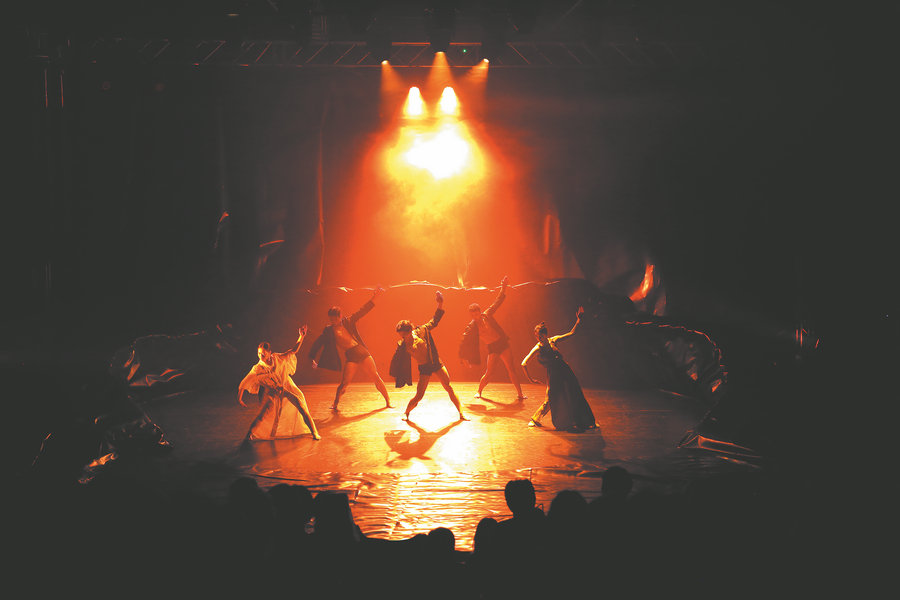

In the Tang Dynasty (618-907), a genre of fictional short stories called chuanqi (legends) with themes of heroism, romance and fantasy, embodied the rich imagination of ancient people. Chuanqi endured for generations to influence literature, TV series, films and stage productions.
Theater director, dancer and choreographer Zheng Jie has been a fan of these stories since he was young. He was inspired to interpret some of his favorite stories through dance, which he developed into the choreodrama series Three Rules of Admonition.
A choreodrama is a drama expressed in dance or with dance as an integral part of its content, performed by a group of dancers.
From June 23 to 24, the second production of the series The Tiger Man by Zheng Jie Dance Theater held two performances at the Sibiu International Theatre Festival in Romania.
The story is based on a legend from the late Tang Dynasty Ren Hu Zhuan (Tale of the Man Tiger), which was later adapted by Japanese author Atsushi Nakajima into the famed short story The Moon Over the Mountain.
Zheng's work is an adaptation merging both versions. The story centers on Li Zheng who gives up his career as a Tang Dynasty official to pursue his aspiration of becoming an accomplished poet. However, his literary pursuits fail, and defeated, he eventually transforms into a tiger.
"When I first read the story, it resonated deeply," Zheng says. At the time, he was working on the first part of the series, The Assassin, which is based on the tale of Nie Yinniang, a girl who grows up to be an assassin and a recluse.
"While Nie Yinniang embodies a journey of growing up and deciding who she wants to become, the tiger man starts his life at the peak but gradually falls into disillusionment and emptiness."
Yao Shuo, the production's dramaturge, says he sees the dilemma in the story between people's expectations of themselves and reality.
"This story mirrors the lives of many average individuals who have similar experiences to the protagonist — doing well as students and believing that they will achieve great things only to find themselves in mundane jobs. Facing such disappointment, they might gradually fall into frustration and self-doubt," Yao says.

The choreographed drama's poignant themes also make it a fitting component of the Three Rules of Admonition series, which uses ancient Chinese texts as a wake-up call for contemporary audiences, reminding them to reflect on their own lives.
"As long as people begin to contemplate their life and work, they can find their own paths and solutions. We provide content that evokes empathy, allowing people to consider whether or not they need to make new decisions," Yao says.
According to Zheng, the choreodrama series highlights a human-centered approach and takes the audience on a journey of self-discovery and understanding.
"I enjoy reading Chinese legends centered on human experiences. The story of Nie Yinniang captivated me with its intricate plot and narrative. I became deeply engrossed in it, so the story led to my series," says Zheng.
"The fantastical and bizarre elements in these legends highlight common questions facing many people in the contemporary era — who am I? What am I going to do? I believe that these stories can resonate with many people, infusing them with inner strength or a sense of connection."
In the production, the protagonist is portrayed by three male dancers, each embodying a different phase of the character — the aspiring poet, the troubled soul struggling with inner conflict and finally, the tiger with its bestial nature.
In terms of choreography, compared with The Assassin, where Zheng focuses on expressing character relations with different dance genres, the emotions in The Tiger Man drive the dancers' body expressions.
The production was commissioned by the China Shanghai International Arts Festival Rising Artists' Works program, an incubation platform helping young artists in various fields create original works.
After its premiere at the Shanghai International Dance Center last October, the team received an invitation from the Sibiu International Theatre Festival.
"For international performances, I made adjustments and created a new version because I want to enhance its appeal to the international market by omitting some storytelling expressions and highlighting the overall emotions," Zheng says.
The creators are also working on the third and final production of the series, which will continue to draw insights from ancient texts and express themes relevant today.
"Traditional culture is not about imitating the ways of ancient people, but rather inheriting our own intellectual history while passing down the tangible culture. I think it is meaningful to find the recurring themes in traditional thought that can strike a chord with what we're facing right now," Yao says.